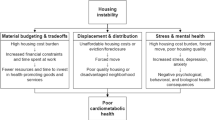Abstract
Studies have shown that households subsidized with vouchers live in higher quality units and exhibit fewer physical, mental, and social problems than do their peers living in public housing. However, none of these studies have included cardiovascular outcomes. The objective of this study was to assess if use/type of rental assistance is independently associated with poor cardiovascular health among Latino adults (ages ≥18) who are eligible for federal low-income rental assistance and living in the Bronx, NY. Data from the cross-sectional, Affordable Housing as an Obesity Mediating Environment study, collected over 18 months (January 2011 to August 2012) were used. The prevalence of cardiovascular disease (CVD) outcomes was determined by measured high blood pressure and self-reported heart attack and/or stroke. Type of housing status was defined as: public housing units, units subsidized by section 8 vouchers, and units unassisted by either federal program. Statistical techniques used were analysis of variance and multivariate logistic regression. The prevalence of CVD was significantly higher among public housing residents than unassisted participants even in the presence of all individual level covariates. Public housing residents also have higher levels of CVD than do section 8 participants. The prevalence of CVD was similar for unassisted and section 8 participants. These findings point to the potential for health benefits arising from housing voucher use even within a fairly delimited geographic area.
Similar content being viewed by others
References
Fauth RC, Leventhal T, Brooks-Gunn J. Short-term effects of moving from public housing in poor to middle-class neighborhoods on low-income, minority adults’ outcomes. Soc Sci Med. 2004; 59(11): 2271–2284. Epub 2004/09/29.
Rosenbaum E, Harris LE. Residential mobility and opportunities: early impacts of the Moving to Opportunities Demonstration Program in Chicago. Housing Policy Debate. 2001; 12(2): 321–346.
Leventhal T, Brooks-Gunn J. Moving to opportunity: an experimental study of neighborhood effects on mental health. Am J Public Health. 2003; 93(9): 1576–1582.
Sanbonmatsu L, Marvakov J, Potter NA, et al. The long-term effects of moving to opportunity on adult health and economic self-sufficiency. Cityscape. 2012; 14(2): 109–137.
Ludwig J, Sanbonmatsu L, Gennetian L, et al. Neighborhoods, obesity, and diabetes—a randomized social experiment. N Engl J Med. 2011; 365(16): 1509–1519. Epub 2011/10/21.
Sanbonmatsu L, Ludwig J, Katz L, et al. Moving to opportunity for fair housing demonstration program: final impacts evaluation. Washington, D.C.: 2011. http://www.huduser.org/portal/publications/pubasst/MTOFHD.html. Accessed 5 May 2013.
Rosenbaum E, Friedman S. The housing divide: how generations of immigrants fare in New York’s Housing Market. New York: New York University Press; 2007.
Friedman S, Schill M, Rosenbaum E. The use of rental housing assistance by immigrants in the United States and New York City. Hous Policy Debate. 1999; 10(2): 443–475.
Charlson ME, Pompei P, Ales KL, et al. A new method of classifying prognostic comorbidity in longitudinal studies: development and validation. J Chronic Dis. 1987; 40(5): 373–383. Epub 1987/01/01.
Lemelin ET, Diez Roux AV, Franklin TG, et al. Life-course socioeconomic positions and subclinical atherosclerosis in the multi-ethnic study of atherosclerosis. Soc Sci Med. 2009; 68(3): 444–451.
Wight RG, Cummings JR, Miller-Martinez D, et al. A multilevel analysis of urban neighborhood socioeconomic disadvantage and health in late life. Soc Sci Med. 2008; 66(4): 862–872.
Harrison RA, Gemmell I, Heller RF. The population effect of crime and neighbourhood on physical activity: an analysis of 15,461 adults. J Epidemiol Community Health. 2007; 61(1): 34–39.
Estabrooks PA, Lee RE, Gyurcsik NC. Resources for physical activity participation: does availability and accessibility differ by neighborhood socioeconomic status? Ann Behav Med. 2003; 25(2): 100–104.
Morland K, Wing S, Diez Roux A, et al. Neighborhood characteristics associated with the location of food stores and food service places. Am J Prev Med. 2002; 22(1): 23–29.
Inagami S, Cohen DA, Finch BK, et al. You are where you shop: grocery store locations, weight, and neighborhoods. Am J Prev Med. 2006; 31(1): 10–17.
Acknowledgments
The AHOME Study is funded by a grant from the John D. and Catherine T. MacArthur Foundation’s “How Housing Matters to Families and Communities” research program (grant no. 94005-0). The authors would also like to acknowledge the contribution of the AHOME clinical interviewers and student interns whose dedication made this study possible.
Author information
Authors and Affiliations
Corresponding author
Electronic supplementary material
Below is the link to the electronic supplementary material.
ESM 1
(DOCX 311 kb)
Rights and permissions
About this article
Cite this article
Chambers, E.C., Rosenbaum, E. Cardiovascular Health Outcomes of Latinos in the Affordable Housing as an Obesity Mediating Environment (AHOME) Study: A Study of Rental Assistance Use. J Urban Health 91, 489–498 (2014). https://doi.org/10.1007/s11524-013-9840-9
Published:
Issue Date:
DOI: https://doi.org/10.1007/s11524-013-9840-9



